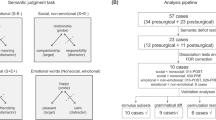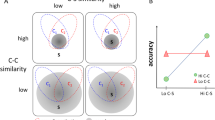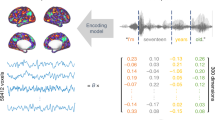Abstract
An abnormal facilitation of the spreading activation within semantic networks is thought to underlie schizophrenics' remote associations and referential ideas. In normal subjects, elevated magical ideation (MI) has also been associated with a style of thinking similar to that of schizotypal subjects. We thus wondered whether normal subjects with a higher MI score would judge “loose associations” as being more closely related than do subjects with a lower MI score. In two experiments, we investigated whether judgments of the semantic distance between stimulus words varied as a function of MI. In the first experiment, random word pairs of two word classes, animals and fruits, were presented. Subjects had to judge the semantic distance between word pairs. In the second experiment, sets of three words were presented, consisting of a pair of indirectly related, or unrelated nouns plus a third noun. Subjects had to judge the semantic distance of the third noun to the word pair. The results of both experiments showed that higher MI subjects considered unrelated words as more closely associated than did lower MI subjects. We conjecture that for normal subjects high on MI “loose associations” may not be loose after all. We also note that the tendency to link uncommon, nonobvious, percepts may not only be the basis of paranormal and paranoid ideas of reference, but also a prerequisite of creative thinking.
Similar content being viewed by others
REFERENCES
Bleuler, E. (1911/1950). Dementia praecox or the group of schizophrenias. New York: International Universities Press.
Brugger, P., & Graves, R. E. (1997). Testing vs. believing hypotheses: magical ideation in the judgment of contingencies. Cognitive Neuropsychiatry 2, 251–272.
Brugger, P., Regard, M., Landis, T., & Graves, R. E. (1995). The roots of meaningful coincidence. Lancet 345, 1306–1307.
Chapman, L. J., Chapman, J. P., Kwapil, T. R., Eckblad, M., & Zinser, M. C. (1994). Putatively psychosis-prone subjects 10 years later. Journal of Abnormal Psychology, 103, 171–183.
Duchêne, A., Graves, R., & Brugger, P. (1998). Schizotypal thinking and associative processing: a response commonality analysis of verbal fluency. Journal of Psychiatry and Neuroscience 23, 56–60.
Eckblad, M., & Chapman, L. J. (1983). Magical ideation as an indicator of schizotypy. Journal of Consulting and Clinical Psychology 51, 215–255.
Garety, P., & Wessely, S. (1994). The assessment of positive symptoms. In T. R. E. Barnes, & H. E. Nelson, (Eds.), The assessment of psychoses. A practical handbook, (pp. 21–39). London: Chapman and Hall.
Gianotti, L. R. R., Mohr, C., Pizzagalli, D., Lehmann, D., & Brugger, P. (in press). Associative processing and paranormal belief. Psychiatry and Clinical Neurosciences.
Kwapil, T. R., Chapman, L. J., & Chapman, J. P. (1999). Validity and usefulnes of the Wisconsin Manual for assessing psychotic-like experiences. Schizophrenia Bulletin 25, 363–375.
Kwapil, T. R., Hegley, D., Chapman, L. J., & Chapman, J. P. (1990). Facilitation of word recognition by semantic priming in schizophrenia. Journal of Abnormal Psychology 99, 215–221.
Lenzenweger, M. F. (1994). The psychometric high-risk paradigm, perceptual aberrations, and schizotypy: An update. Schizophrenia Bulletin 20, 121–135.
Leonhard, D., & Brugger, P. (1998). Creative, paranormal, and delusional thought: a consequence of right hemisphere semantic activation? Neuropsychiatry, Neuropsychology, and Behavioral Neurology 11, 177–183.
Levine, J., Schild, K., Kimhi, R., & Schreiber, G. (1996). Word associative production in affective versus schizophrenic psychosis. Psychopathology 29, 7–13.
Manschreck, T. C., Maher, B. A., Milavetz, J. J., Ames, D., Weisstein, C. C., & Schneyer, M. L. (1988). Semantic priming in thought disordered schizophrenic patients. Schizophrenia Research 1, 61–68.
Mednick, S. A. (1962). The associative basis of the creative process. Psychological Review 69, 220–232.
Merten, T. (1993). Word association responses and psychoticism. Personality and Individual Differences 14, 837–839.
Miller, E. N., & Chapman, L. J. (1983). Continued word association in hypothetically psychosis-prone college students. Journal of Abnormal Psychology 92, 468–487.
Pizzagalli, D., Lehmann, D., & Brugger, P. (2001). Lateralized direct and indirect semantic priming effects in subjects with paranormal experiences and beliefs. Psychopathology, 34, 75–80.
Reilly, R., Harrow, M., Tucker, G., Quinlan, D., & Siegel A. (1975). Looseness of associations in acute schizophrenia. British Journal of Psychiatry 127, 240–246.
Sommer, R., Dewar, R., Osmond, H., & Sask, W. (1960). Is there a schizophrenic language? Archives General Psychiatry 3, 665–673.
Spitzer, M. A cognitive neuroscience view of schizophrenia thought disorder. Schizophrenia Bulletin 23, 29–50.
Spitzer, M., Braun, U., Hermle, L., & Maier, S. (1993). Associative semantic network dysfunction in thought-disordered schizophrenic patients: Direct evidence from indirect semantic priming. Biological Psychiatry 34, 864–877.
Thalbourne, M. A. (1994). Belief in the paranormal and its relationship to schizophrenia-relevant measures: A confirmatory study. British Journal of Clinical Psychology 33, 78–80.
Weisbrod, M., Maier, S., Harig, S., Himmelsbach, U., & Spitzer, M. (1998). Lateralised semantic and indirect priming effects in people with schizophrenia. British Journal of Psychiatry 172, 142–146.
Author information
Authors and Affiliations
Rights and permissions
About this article
Cite this article
Mohr, C., Graves, R.E., Gianotti, L.R.R. et al. Loose but Normal: A Semantic Association Study. J Psycholinguist Res 30, 475–483 (2001). https://doi.org/10.1023/A:1010461429079
Issue Date:
DOI: https://doi.org/10.1023/A:1010461429079




